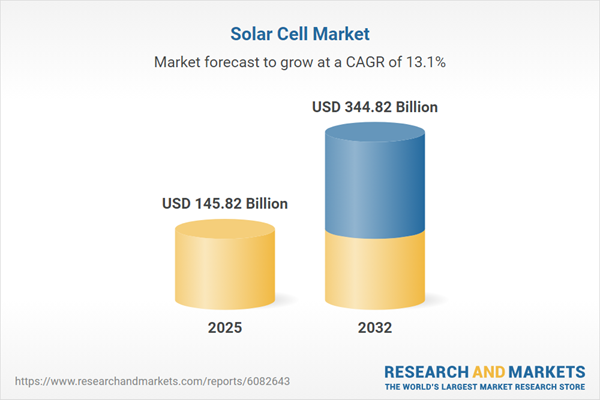Speak directly to the analyst to clarify any post sales queries you may have.
The Solar Cell Market is rapidly shaping global energy strategies, providing senior decision-makers with avenues to accelerate clean energy objectives and improve resilience. Continuous technology advancement, adaptive business models, and favorable policy frameworks position solar solutions as essential pillars for forward-looking organizations in the energy transition.
Market Snapshot: Solar Cell Market Growth and Investment Momentum
The global Solar Cell Market grew from USD 128.58 billion in 2024 to USD 145.82 billion in 2025, demonstrating sustained growth and robust investment momentum across major regions. With a projected CAGR of 13.12%, the market is anticipated to exceed USD 344.82 billion by 2032.
This sustained uptrend is fueled by cost-driven technological innovations, increased capital allocations toward achieving carbon neutrality, and ongoing regulatory encouragement. Solar photovoltaic systems are gaining strategic importance in grid modernization initiatives, enhanced by evolving financing tools and expanding digital integration.Scope & Segmentation
This market research report delivers actionable insights for organizations evaluating revenue opportunities and operational approaches within the Solar Cell Market. Executive teams can align strategic decisions based on detailed, future-oriented segmentation:
- Technology: Includes crystalline silicon (monocrystalline and polycrystalline) and thin film (amorphous silicon, cadmium telluride, copper indium gallium selenide) for tailored deployments and varying efficiency needs.
- Application: Commercial, residential, and utility-scale usage allow stakeholders to match technical solutions to diverse market segments.
- Installation: Floating solar, ground-mounted systems (both fixed tilt and tracking), and rooftop installations (building-attached or building-integrated) broaden project siting options for varied infrastructures.
- End User: Government bodies, commercial enterprises, industrial sectors, and residential users reflect the expanding buyer landscape and shifting demand patterns.
- Region: Coverage across Americas (United States, Canada, Mexico, Brazil, Argentina, Chile, Colombia, Peru), Europe, Middle East & Africa (notably United Kingdom, Germany, France, Saudi Arabia, South Africa, Nigeria), and Asia-Pacific (China, India, Japan, Australia, South Korea, Indonesia) ensures relevance for organizations operating globally.
- Key Companies: Profiles of market leaders such as LONGi Green Energy Technology Co., Ltd., JinkoSolar Holding Co., Ltd., JA Solar Technology Co., Ltd., Trina Solar Co., Ltd., Canadian Solar Inc., First Solar, Inc., Hanwha Q CELLS Co., Ltd., Risen Energy Co., Ltd., GCL System Integration Technology Co., Ltd., and Seraphim Energy Group Co., Ltd. aid in competitive positioning and partnership considerations.
Key Takeaways for Senior Decision-Makers
- Crystalline silicon dominates most commercial and residential projects. Thin film variants are increasingly favored where lighter weight or flexible design solutions are prioritized.
- Tandem and heterojunction cell technologies are enhancing efficiency benchmarks, while digital analytics are enabling streamlined asset management and improved integration across power systems.
- Navigating varying regional regulatory frameworks, from longer permitting cycles in European markets to rapid scaling opportunities in Asia-Pacific, requires adaptable market-entry and execution models.
- The integration of energy storage and predictive maintenance strategies is transforming operational economics and emphasizing the importance of comprehensive service offerings in the value chain.
- Manufacturers are responding to client demands through vertical integration, custom product development, and active research collaborations to expedite technology adoption and innovation cycles.
- Recent tariff updates and evolving trade policies are intensifying the need for robust supply chain risk management and incentivizing the development of local manufacturing capabilities.
Tariff Impact on Global Supply Chains
Tariff adjustments in the United States have directly influenced sourcing and production plans throughout the Solar Cell Market. Many developers are revising supplier contracts and boosting investment in domestic capacity to maintain supply chain continuity. These developments have prompted changes in project financing strategies, increasing the importance of adaptive plans to mitigate heightened price variations and evolving trade flows. For leadership teams, understanding tariff implications is necessary for proactive risk management and sustainable capital allocation.
Methodology & Data Sources
This analysis synthesizes secondary research from industry reports, regulatory filings, and company statements, combined with primary insights from interviews with sector leaders and technical experts. Cross-validation using data triangulation and scenario modeling ensures the reliability and depth of insights for organizations assessing the Solar Cell Market or planning new technology investments.
Why This Report Matters
- Helps executive decision-makers align technology selection and investment strategies with market-specific trends and shifting regional policy factors.
- Clarifies risks relating to supply chain disruptions, regulatory changes, and tariff exposures, enabling robust and forward-looking risk management practices.
- Provides perspective on evolving competitive dynamics, business model shifts, and innovation pathways to support sustained growth and market leadership.
Conclusion
The Solar Cell Market is undergoing rapid transformation, shaped by advancements in technology, evolving regulations, and changing business dynamics. This report empowers senior decision-makers with intelligence to navigate complexity and pursue agile, informed growth strategies in the solar sector.
Table of Contents
3. Executive Summary
4. Market Overview
7. Cumulative Impact of Artificial Intelligence 2025
Companies Mentioned
The companies profiled in this Solar Cell market report include:- LONGi Green Energy Technology Co., Ltd.
- JinkoSolar Holding Co., Ltd.
- JA Solar Technology Co., Ltd.
- Trina Solar Co., Ltd.
- Canadian Solar Inc.
- First Solar, Inc.
- Hanwha Q CELLS Co., Ltd.
- Risen Energy Co., Ltd.
- GCL System Integration Technology Co., Ltd.
- Seraphim Energy Group Co., Ltd.
Table Information
| Report Attribute | Details |
|---|---|
| No. of Pages | 190 |
| Published | October 2025 |
| Forecast Period | 2025 - 2032 |
| Estimated Market Value ( USD | $ 145.82 Billion |
| Forecasted Market Value ( USD | $ 344.82 Billion |
| Compound Annual Growth Rate | 13.1% |
| Regions Covered | Global |
| No. of Companies Mentioned | 11 |









